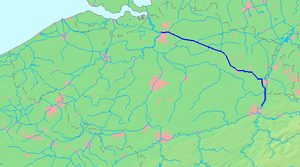Albert Canal
This article needs additional citations for verification. (December 2009) |
| Albert Canal | |
|---|---|
 Albert Canal in Geel | |
 | |
| Specifications | |
| Length | 80.5 miles (129.6 km) |
| Locks | 6 |
| History | |
| Construction began | 1930 |
| Date of first use | 1939 |
| Geography | |
| Start point | Liège |
| End point | Antwerp |

The Albert Canal (Dutch: Albertkanaal, pronounced [ˈɑl.bərt.kaːˌnaːl]; French: Canal Albert, pronounced [kanal albɛʁ]) is a canal located in northeastern Belgium, which was named for King Albert I of Belgium. The Albert Canal connects Antwerp with Liège, and also the Meuse river with the Scheldt river. It also connects with the Dessel–Turnhout–Schoten Canal, and its total length is 129.5 kilometres (80.5 mi).
Size and geography
The Albert Canal has a standard depth of 3.4 metres (11 ft) and an overhead clearance of 6.7 metres (22 ft). To allow four-stacked container traffic, bridges over the canal are currently being heightened to allow for a 9.1 metres (30 ft) overhead.
Between Antwerp and Liège, there is a difference in elevation of 56 metres (184 ft), and six sets of
During most of the 1930s, before the completion of the Albert Canal, it took about seven days to travel from Antwerp to Liège by water. In the 21st century, that same distance can be covered in about 18 hours.
History



The Albert Canal was constructed from 1930 through 1939. The German construction company
During World War II, the Albert Canal functioned as a defence line. The crossing of the canal by the German forces and the destruction of
During the Liberation of Belgium by the Allies in September 1944, the
Today
In 2002, the canal carried a record 43 million tons of goods of various kinds, amounting to more than half the Belgian waterway total.[1]
The canal is also a popular leisure and cycling destination, with well paved service roads on both sides traversing picturesque farm land, particularly around Smeermaas, Lanaken and Maasmechelen.[1]
Notes
- ^ a b "Cycling Belgium's Waterways: Albert Canal", Gamber.net, archived from the original on 2016-03-04, retrieved 10 October 2015
